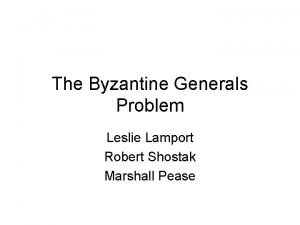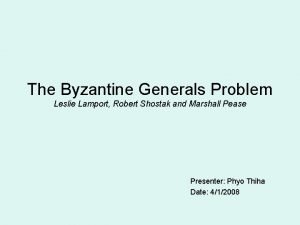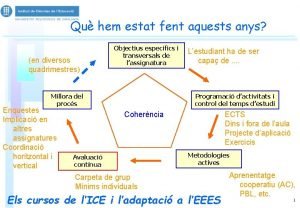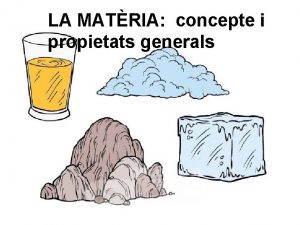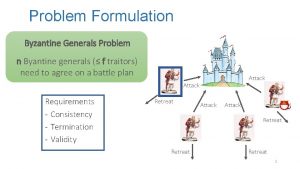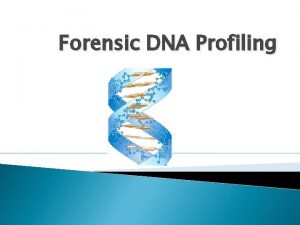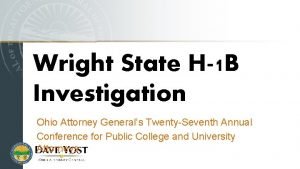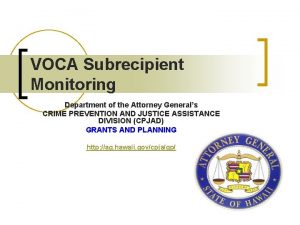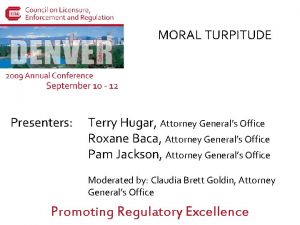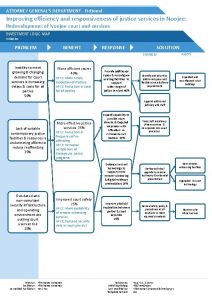FORENSIC DNA ASSESSMENT Attorney Generals Initiative on DNA














- Slides: 14

FORENSIC DNA ASSESSMENT Attorney General's Initiative on DNA Laboratory Backlog Working Group Meeting October 21 & 22 – Washington, DC Presented by: Smith Alling Lane, P. S. Tacoma, WA (253) 627 -1091 Washington, DC (202) 258 -2301 London 011 (44) 798 953 8386 Tim Schellberg, J. D. tims@smithallinglane. com Lisa Hurst lhurst@smithallinglane. com

The Next Five Years: Goals for DNA Advocates 1. All felons databases in all but a few states 2. Casework backlogs cleared 3. Routine casework at all relevant crime scene State legislators State agencies responsible for crime labs Congress US Department of Justice Law enforcement City and County government

Policy Makers Want DATA, FACTS, NUMBERS. . . Four questions policy makers want answered 1. What does passing DNA database expansion legislation do to the odds of solving a particular crime? 2. With funding to complete all DNA casework (past, current, future) how many crimes will be solved? This would include an assessment of how many untested rape kits exist. 3. How many crimes, particularly rapes and homicides, could be prevented if database legislation is passed and all casework (past, current, future) is completed? 4. Will expanded databases and casework funding create financial efficiencies for the criminal justice system? What are the anticipated savings?

Forensic DNA Assessment Project • NIJ has awarded a grant to Smith Alling Lane, working in partnership with Washington State University, to answer these questions. • Assessment questionnaire will be sent to – state labs – local law enforcement agencies • All agencies with 100 or more officers (approximately 1000). • A statistically valid sampling of remaining agencies (approximately 2000). • Indian tribes

TIMELINE • Assessment tool will be mailed on November 1, 2002. • Preliminary report to NIJ by the end of January 2003 (in time for congressional budgets). • Report updates every two months until report is finalized (targeted at June 2003).

STATUS • Assessment is in final review. Reviewers include: – National Institute of Justice – Washington State University – State Laboratory representatives – Local Agency representatives

ENSURING RESULTS • Assessment mailing will include two follow-up mailings to all non-respondents • Personal calls will be made to all forensic labs – identification of respondent designee • Personal calls will be made to all local agencies with more than 100 officers – identification of respondent designee – coordination between units, as necessary • Personal calls will be made to remaining local agencies, as time permits.

THE PROJECT GOAL IS NOT …to obtain a statistical survey of laboratory backlogs …to complete a census of the untested DNA evidence at every local law enforcement agency in the country

THE PROJECT GOAL IS …to provide a general assessment of the use of forensic DNA by law enforcement …to give a base from which extrapolations may be made projecting the national DNA backlog …to educate on the importance of expanded, operational forensic DNA programs and databases

QUESTION 1: What does passing DNA database expansion legislation do to the odds of solving a particular crime? – Extensive review of CODIS successes • Types of crimes solved and types of offenders linked to crimes • Criminal history of offenders • Investigations aided – Case studies, as needed • Successes of Virginia and Florida • New York data – 75% of first 500 hits a result of 1999 expansion.

QUESTION 2: With funding to complete all DNA casework (past, current, future) how many crimes will be solved? – Assessment of backlog • Rape kits, cold cases, property crimes • Numbers from state labs, local labs and local agencies • Analysis turn-around time – Report on state of DNA casework • Types and numbers of cases being analyzed – Comparisons of success in all-felons states

QUESTION 3: How many crimes, particularly rapes and homicides, could be prevented if database legislation is passed and all casework (past, current, future) is completed? – Crime rates and crime scene DNA collection rates – Case studies • Serial offenders with criminal histories • Backlogs that delayed the identification of offenders – Comparisons of success in all-felons states

• QUESTION 4: Will expanded databases and casework funding create financial efficiencies for the criminal justice system? What are the anticipated savings? – Forensic DNA needs of labs – Historic funding levels from local, state, federal – Case studies: • Identifying (or excluding) suspects quickly • Prosecuting DNA cases

YOUR QUESTIONS
 Forensic pathologist vs forensic anthropologist
Forensic pathologist vs forensic anthropologist Who is this
Who is this How many generals divided alexander's empire?
How many generals divided alexander's empire? Murphy repertory rubrics
Murphy repertory rubrics Byzantine generals problem game theory
Byzantine generals problem game theory How many generals divided alexander's empire?
How many generals divided alexander's empire? Alexander the great four generals
Alexander the great four generals Leslie lamport byzantine
Leslie lamport byzantine Leslie lamport byzantine
Leslie lamport byzantine Verbs objectius d'aprenentatge
Verbs objectius d'aprenentatge Propietats generals
Propietats generals Byzantine generals problem origin
Byzantine generals problem origin General byzantine problem
General byzantine problem Byzantine generals problem
Byzantine generals problem Words that rhyme with phil
Words that rhyme with phil







